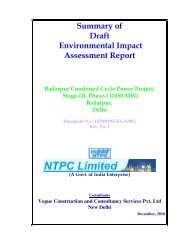proposed integrated complex for delhi judicial academy
proposed integrated complex for delhi judicial academy
proposed integrated complex for delhi judicial academy
You also want an ePaper? Increase the reach of your titles
YUMPU automatically turns print PDFs into web optimized ePapers that Google loves.
Rapid Environmental Impact Assessment (REIA) Study <strong>for</strong> Proposed Integrated Complex <strong>for</strong> Delhi Judicial Academy,<br />
National Law School, and National Institute <strong>for</strong> Mediation & Conciliation at Dwarka, New Delhi<br />
A substantial portion of the basement will be utilized <strong>for</strong> the pump room. It is estimated about<br />
60% of the water requirement will be met through piped water supply from DJB and the<br />
remaining from ground water.<br />
3.1.8 Sewage Collection, Treatment and Disposal System<br />
It is <strong>proposed</strong> to establish one STP of 250 m 3 /day capacity in the <strong>complex</strong> based on aerobic<br />
Fluidized Bed Reactor Technology. The wastewater generated will be treated up to tertiary level.<br />
The single STP will serve both the academic and residential <strong>complex</strong>. The wastewater will be<br />
collected through a network of drainage system to be designed accordingly keeping in view the<br />
location of the STP. The treated effluent will be mostly reused <strong>for</strong> flushing of toilets in the<br />
residential <strong>complex</strong> and <strong>for</strong> gardening. Dual plumbing system will be provided <strong>for</strong> utilizing<br />
treated water <strong>for</strong> flushing of toilets. Unutilized treated effluent shall be discharged into the<br />
municipal sewerage network which is available around the <strong>proposed</strong> site. Reuse of treated<br />
effluent within the <strong>complex</strong> will reduce the overall requirement of fresh water as well as put less<br />
load on the existing sewerage network.<br />
During the project construction phase, the major source of water pollution will be sewage from<br />
labour camps and makeshift office. It is expected that at any given time during the construction<br />
phase, the peak manpower strength on construction site comprising of technical staff,<br />
clerical/supervisor, skilled and unskilled workers would be about 500 persons. The average<br />
domestic water requirements would be about 50 lpcd. Thus, total water requirements work out to<br />
be 25,000 litres / day (max.). It is assumed that about 80% of the water required will be<br />
generated as sewage. Thus, total quantum of sewage generated in peak situation is expected to be<br />
about 20,000 litres / day. The generated sewage would pass through a septic tank and its<br />
discharge would be connected to the existing municipal sewage network of the area.<br />
3.1.9 Storm Water Drainage System<br />
All along the road storm water drains would be provided to collect water during rains. They<br />
would be adequately sized to prevent over flooding of the site. The storm water collection system<br />
will be designed in such a manner so that clean storm water from garden, parking areas,<br />
roadways and lawns is used <strong>for</strong> recharging of ground water. The excess run off will be directed<br />
towards the nearest storm water drain.<br />
37
















